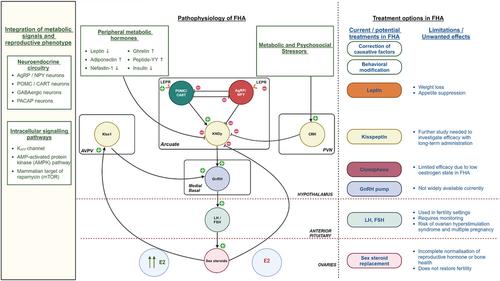当前位置:
X-MOL 学术
›
Ann. N. Y. Acad. Sci.
›
论文详情
Our official English website, www.x-mol.net, welcomes your
feedback! (Note: you will need to create a separate account there.)
Kisspeptin in functional hypothalamic amenorrhea: Pathophysiology and therapeutic potential
Annals of the New York Academy of Sciences ( IF 4.1 ) Pub Date : 2024-09-17 , DOI: 10.1111/nyas.15220 Aaran H Patel 1, 2 , Kanyada Koysombat 1, 3 , Aureliane Pierret 1 , Megan Young 1 , Alexander N Comninos 1, 3 , Waljit S Dhillo 1, 3 , Ali Abbara 1, 3
Annals of the New York Academy of Sciences ( IF 4.1 ) Pub Date : 2024-09-17 , DOI: 10.1111/nyas.15220 Aaran H Patel 1, 2 , Kanyada Koysombat 1, 3 , Aureliane Pierret 1 , Megan Young 1 , Alexander N Comninos 1, 3 , Waljit S Dhillo 1, 3 , Ali Abbara 1, 3
Affiliation

|
Functional hypothalamic amenorrhea (FHA) is one of the most common causes of secondary amenorrhea, resulting in anovulation and infertility, and is a low estrogen state that increases the risk of cardiovascular disease and impairs bone health. FHA is characterized by acquired suppression of physiological pulsatile gonadotropin-releasing hormone (GnRH) release by the hypothalamus in the absence of an identifiable structural cause, resulting in a functional hypogonadotropic hypogonadism. FHA results from either decreased energy intake and/or excessive exercise, leading to low energy availability and weight loss—often in combination with psychological stress on top of a background of genetic susceptibility. The hypothalamic neuropeptide kisspeptin is a key component of the GnRH pulse generator, tightly regulating pulsatile GnRH secretion and the downstream reproductive axis. Here, we review the physiological regulation of pulsatile GnRH secretion by hypothalamic kisspeptin neurons and how their activity is modulated by signals of energy status to affect reproductive function. We explore endocrine factors contributing to the suppression of GnRH pulsatility in the pathophysiology of FHA and how hypothalamic kisspeptin neurons likely represent a final common pathway through which these factors affect GnRH pulse generation. Finally, we discuss the therapeutic potential of kisspeptin as a novel treatment for women with FHA.
中文翻译:

Kisspeptin 治疗功能性下丘脑闭经的病理生理学和治疗潜力
功能性下丘脑闭经 (FHA) 是继发性闭经的最常见原因之一,导致无排卵和不孕,是一种低雌激素状态,会增加患心血管疾病的风险并损害骨骼健康。FHA 的特征是在没有可识别的结构性原因的情况下,下丘脑对生理性搏动性促性腺激素释放激素 (GnRH) 的获得性抑制,导致功能性低促性腺激素性腺功能减退症。FHA 是由于能量摄入减少和/或过度运动造成的,导致能量可用性低和体重减轻——通常与遗传易感性背景之上的心理压力相结合。下丘脑神经肽 kisspeptin 是 GnRH 脉冲发生器的关键组成部分,严格调节搏动性 GnRH 分泌和下游生殖轴。在这里,我们回顾了下丘脑 kisspeptin 神经元对脉动性 GnRH 分泌的生理调节,以及它们的活动如何受到能量状态信号的调节以影响生殖功能。我们探讨了在 FHA 的病理生理学中导致抑制 GnRH 搏动的内分泌因素,以及下丘脑 kisspeptin 神经元如何可能代表这些因素影响 GnRH 脉冲生成的最终共同途径。最后,我们讨论了 kisspeptin 作为 FHA 女性新疗法的治疗潜力。
更新日期:2024-09-17
中文翻译:

Kisspeptin 治疗功能性下丘脑闭经的病理生理学和治疗潜力
功能性下丘脑闭经 (FHA) 是继发性闭经的最常见原因之一,导致无排卵和不孕,是一种低雌激素状态,会增加患心血管疾病的风险并损害骨骼健康。FHA 的特征是在没有可识别的结构性原因的情况下,下丘脑对生理性搏动性促性腺激素释放激素 (GnRH) 的获得性抑制,导致功能性低促性腺激素性腺功能减退症。FHA 是由于能量摄入减少和/或过度运动造成的,导致能量可用性低和体重减轻——通常与遗传易感性背景之上的心理压力相结合。下丘脑神经肽 kisspeptin 是 GnRH 脉冲发生器的关键组成部分,严格调节搏动性 GnRH 分泌和下游生殖轴。在这里,我们回顾了下丘脑 kisspeptin 神经元对脉动性 GnRH 分泌的生理调节,以及它们的活动如何受到能量状态信号的调节以影响生殖功能。我们探讨了在 FHA 的病理生理学中导致抑制 GnRH 搏动的内分泌因素,以及下丘脑 kisspeptin 神经元如何可能代表这些因素影响 GnRH 脉冲生成的最终共同途径。最后,我们讨论了 kisspeptin 作为 FHA 女性新疗法的治疗潜力。


















































 京公网安备 11010802027423号
京公网安备 11010802027423号